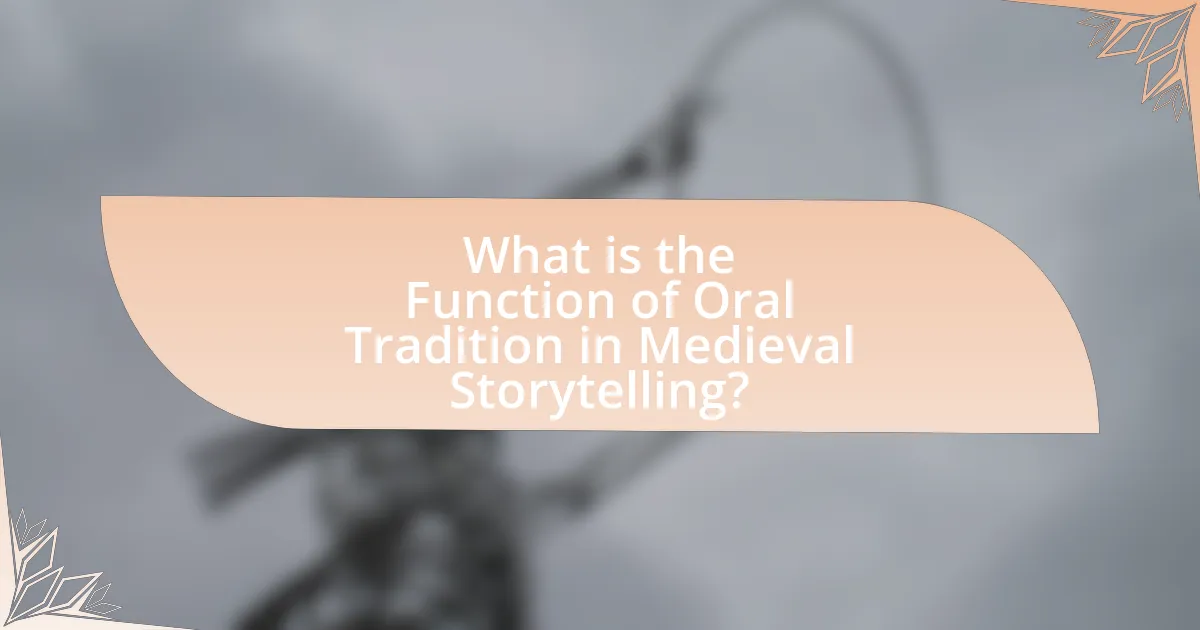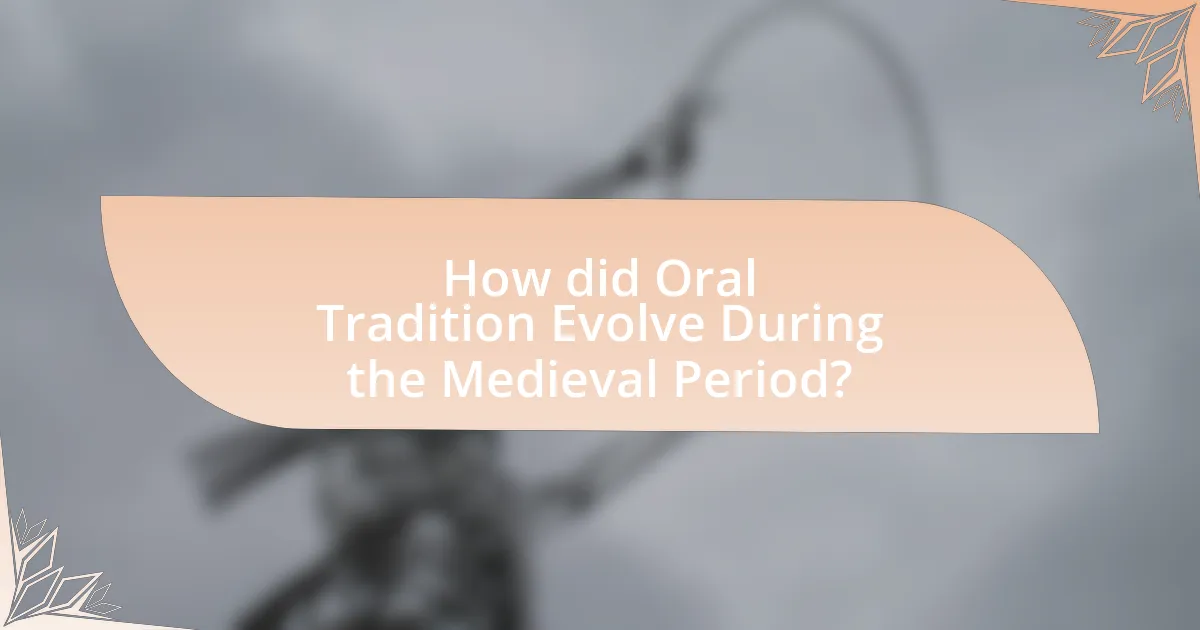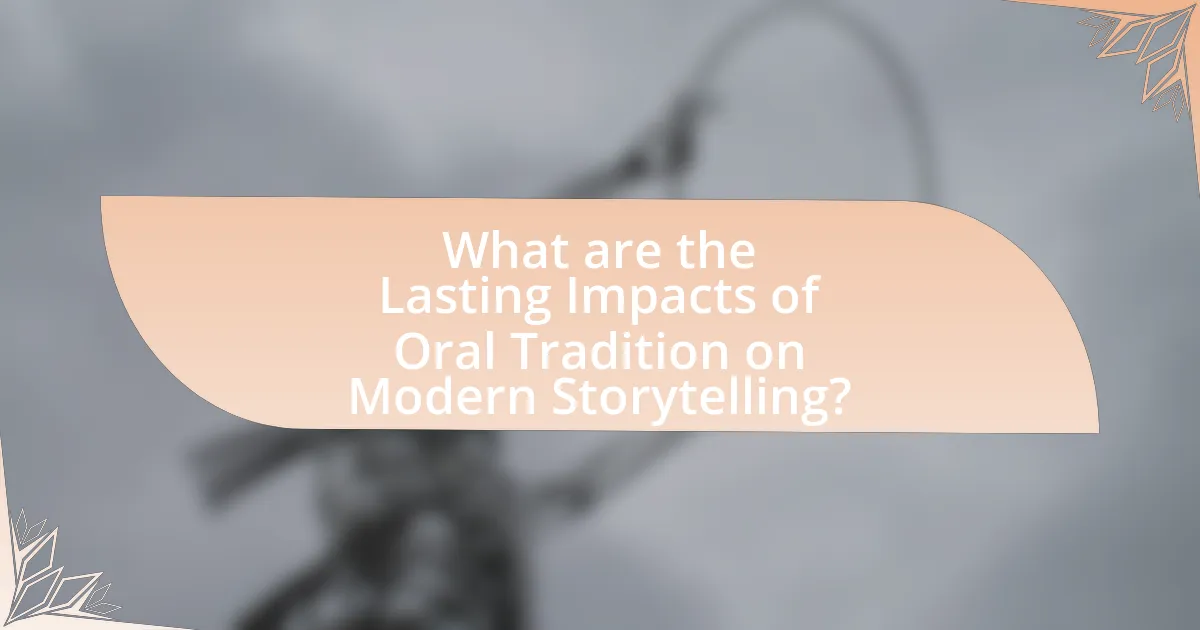The article examines the function of oral tradition in medieval storytelling, highlighting its role in preserving cultural narratives, values, and historical events through spoken word. It discusses how oral tradition shaped narratives by allowing for audience engagement and adaptation, ensuring relevance across generations. Key characteristics of oral storytelling, such as repetition and audience participation, are explored, along with the influence of oral tradition on collective memory and cultural identity. The article also addresses the evolution of oral storytelling techniques and their lasting impact on modern narratives, emphasizing the importance of these traditions in maintaining community cohesion and cultural heritage.

What is the Function of Oral Tradition in Medieval Storytelling?
The function of oral tradition in medieval storytelling is to preserve and transmit cultural narratives, values, and historical events through spoken word. This method allowed communities to maintain their identity and shared knowledge in a time when written records were scarce. Oral tradition facilitated the engagement of audiences, enabling storytellers to adapt tales to reflect contemporary issues and local customs, thereby ensuring relevance and resonance. Historical evidence shows that oral traditions were crucial in shaping the collective memory of societies, as seen in the works of figures like Geoffrey Chaucer and the oral recitations of epic poems such as “Beowulf,” which were passed down through generations before being recorded in written form.
How did oral tradition shape the narratives of the medieval period?
Oral tradition significantly shaped the narratives of the medieval period by serving as the primary means of storytelling, preserving cultural values and historical events. This method allowed for the transmission of tales, legends, and moral lessons across generations, often adapting to the audience’s context and needs. For instance, epic poems like “Beowulf” and “The Song of Roland” were passed down orally before being written, reflecting societal norms and collective memory. The reliance on oral tradition also meant that stories were often embellished or altered, which contributed to the dynamic nature of medieval narratives, allowing them to evolve over time while still maintaining core themes and messages.
What are the key characteristics of oral storytelling in medieval times?
The key characteristics of oral storytelling in medieval times include the use of repetition, audience participation, and the incorporation of local culture and history. Repetition served to reinforce memory and ensure the story was retained accurately, as oral traditions relied on the storyteller’s ability to recall narratives without written texts. Audience participation was crucial, as listeners often engaged with the storyteller through responses or prompts, creating a communal experience. Additionally, oral stories frequently reflected the cultural and historical context of the community, incorporating local legends, moral lessons, and societal values, which helped to preserve and transmit cultural identity across generations.
How did the audience influence the storytelling process?
The audience significantly influenced the storytelling process by actively participating in the oral tradition, shaping narratives through their reactions and feedback. Storytellers often adapted their tales based on audience engagement, such as laughter, gasps, or questions, which indicated what resonated with listeners. This dynamic interaction ensured that stories remained relevant and engaging, as evidenced by historical accounts where oral traditions evolved over time to reflect the values and interests of the community. For instance, in medieval societies, storytellers would modify their performances to align with the cultural context and preferences of their audience, demonstrating the direct impact of listener involvement on the storytelling process.
Why was oral tradition important in preserving history and culture?
Oral tradition was important in preserving history and culture because it served as the primary means of transmitting knowledge, values, and stories across generations before the advent of written language. This method allowed communities to maintain their identity and heritage by sharing collective memories, moral lessons, and cultural practices through storytelling. For instance, many indigenous cultures relied on oral narratives to convey historical events, such as the creation stories of the Aboriginal Australians, which encapsulate their history and connection to the land. Additionally, oral tradition facilitated the preservation of languages and dialects, as seen in the epic poems of the medieval period, which were recited and memorized, ensuring that cultural nuances were passed down intact.
What role did oral tradition play in the transmission of cultural values?
Oral tradition served as a crucial mechanism for transmitting cultural values by enabling the sharing of stories, beliefs, and practices across generations. This method allowed communities to preserve their history, moral lessons, and social norms, ensuring that cultural identity remained intact. For instance, in medieval societies, oral storytelling was often employed to convey ethical teachings and communal values, reinforcing social cohesion and collective memory. The repetition and performance of these narratives helped to embed cultural values deeply within the community, making them accessible and relatable to all members, regardless of age or literacy.
How did oral tradition contribute to the collective memory of communities?
Oral tradition significantly contributed to the collective memory of communities by preserving and transmitting cultural narratives, values, and historical events across generations. This method of storytelling ensured that important communal knowledge, such as genealogies, myths, and significant historical occurrences, was maintained and shared within the community. For instance, in many indigenous cultures, oral traditions served as a primary means of education and social cohesion, allowing members to connect with their heritage and identity. Research indicates that societies relying on oral tradition often have rich, detailed accounts of their past, which are recounted through rituals, songs, and storytelling sessions, reinforcing a shared sense of belonging and continuity.
What are the different forms of oral tradition used in medieval storytelling?
The different forms of oral tradition used in medieval storytelling include epic poetry, ballads, folktales, and proverbs. Epic poetry, such as “Beowulf,” was recited by bards and often conveyed heroic deeds and cultural values. Ballads were narrative songs that told stories of love, tragedy, or historical events, often passed down through generations. Folktales, which included fables and fairy tales, served to impart moral lessons and entertain audiences. Proverbs encapsulated wisdom and cultural norms in concise phrases, facilitating the transmission of knowledge. These forms were essential in preserving history and culture in a largely illiterate society, as they relied on memorization and performance for dissemination.
What types of narratives were commonly shared through oral tradition?
Common types of narratives shared through oral tradition include myths, legends, folktales, and epics. Myths often explain natural phenomena or cultural beliefs, while legends recount historical events or figures, often embellished over time. Folktales typically convey moral lessons or cultural values through entertaining stories, and epics narrate grand adventures or heroic deeds, often associated with specific cultures. These narrative forms were essential in preserving cultural identity and transmitting knowledge across generations in medieval societies.
How did different regions adapt oral traditions to their local contexts?
Different regions adapted oral traditions to their local contexts by incorporating local languages, cultural values, and historical events into their storytelling practices. For instance, in West Africa, griots used local dialects and included community-specific legends to resonate with their audiences, while in the Arctic, Inuit storytelling often featured elements of the natural environment and survival skills relevant to their harsh climate. This adaptation ensured that oral traditions remained relevant and engaging, reflecting the unique identities and experiences of each community. Historical evidence shows that these localized adaptations helped preserve cultural heritage and fostered a sense of belonging among community members.

How did Oral Tradition Evolve During the Medieval Period?
Oral tradition evolved during the Medieval Period through the integration of written texts and the establishment of formal storytelling practices. Initially, oral tradition relied heavily on memory and performance, with bards and storytellers conveying tales through recitation. As literacy increased and the invention of the printing press emerged in the late Medieval Period, stories began to be documented, which allowed for greater preservation and dissemination of narratives. This transition is evidenced by the recording of epic poems and folklore, such as “Beowulf” and “The Canterbury Tales,” which reflect the blending of oral and written forms. The shift not only expanded the audience for these stories but also influenced the structure and style of storytelling, as oral techniques adapted to written formats.
What factors contributed to the evolution of oral storytelling?
The evolution of oral storytelling was primarily influenced by cultural transmission, social cohesion, and the need for entertainment and education. Cultural transmission allowed communities to pass down knowledge, values, and traditions through generations, ensuring the survival of their identity. Social cohesion was fostered as storytelling served as a communal activity that strengthened bonds among individuals, creating a shared history and collective memory. Additionally, oral storytelling provided entertainment and education, as narratives often contained moral lessons and practical knowledge essential for survival. Historical evidence shows that societies relied on oral traditions before the advent of written language, highlighting their significance in shaping cultural narratives and preserving history.
How did the advent of written language impact oral traditions?
The advent of written language significantly transformed oral traditions by providing a permanent record of stories, knowledge, and cultural practices. This shift allowed for the preservation and dissemination of narratives beyond the limitations of memory and performance, which were inherent in oral traditions. For instance, with the development of writing systems, such as cuneiform in Mesopotamia around 3200 BCE, societies could document their histories, laws, and myths, leading to a more standardized and accessible form of storytelling. Consequently, oral traditions began to coexist with written texts, influencing each other; oral storytelling adapted to incorporate written narratives, while written works often drew from oral sources, thereby enriching the cultural tapestry of medieval storytelling.
What changes occurred in storytelling techniques over time?
Storytelling techniques have evolved significantly over time, transitioning from oral traditions to written forms and incorporating various narrative structures. Initially, oral storytelling relied heavily on memorization, repetition, and performance, allowing for communal participation and cultural transmission. As societies developed writing systems, storytelling began to shift towards written narratives, which enabled more complex plots and character development, as seen in ancient texts like Homer’s “Iliad” and “Odyssey.”
The introduction of the printing press in the 15th century further transformed storytelling by making literature more accessible, leading to the rise of novels and diverse genres. In the 20th century, the advent of film and digital media introduced new techniques such as visual storytelling, nonlinear narratives, and interactive formats, exemplified by works like “Pulp Fiction” and video games. These changes reflect a continuous adaptation of storytelling methods to engage audiences in innovative ways, demonstrating the dynamic nature of narrative forms throughout history.
How did oral tradition interact with other storytelling mediums?
Oral tradition interacted with other storytelling mediums by serving as a foundational narrative form that influenced written literature, performance arts, and visual storytelling. In medieval societies, oral narratives were often transcribed into written texts, as seen in works like “Beowulf,” where oral storytelling techniques shaped the structure and themes of the written poem. Additionally, oral traditions influenced theatrical performances, with many plays incorporating elements of folklore and oral tales, thereby enriching the audience’s experience. Historical evidence shows that oral storytelling was a primary means of cultural transmission, which later informed the development of written literature and other artistic expressions, creating a dynamic interplay between these mediums.
What was the relationship between oral tradition and written literature?
Oral tradition served as the foundational basis for written literature, particularly in medieval storytelling. This relationship is evident as oral narratives were initially passed down through generations, preserving cultural values and historical events before being transcribed into written form. For instance, epic poems like “Beowulf” originated from oral storytelling practices, where bards would recite tales, which were later documented, thus bridging the gap between spoken and written word. The transition from oral to written literature allowed for the preservation and dissemination of these narratives, ensuring their survival and influence across time.
How did performance arts influence oral storytelling practices?
Performance arts significantly influenced oral storytelling practices by enhancing the delivery and engagement of narratives. The incorporation of dramatic elements, such as gestures, facial expressions, and vocal modulation, transformed storytelling into a more dynamic and immersive experience. Historical evidence shows that in medieval times, performers often utilized these techniques to captivate audiences, making stories more memorable and impactful. For instance, the use of rhythm and rhyme in oral traditions can be traced back to performance arts, which helped in the retention and transmission of tales across generations. This synergy between performance arts and oral storytelling not only enriched the narrative form but also solidified its role as a communal activity, fostering a shared cultural identity.

What are the Lasting Impacts of Oral Tradition on Modern Storytelling?
The lasting impacts of oral tradition on modern storytelling include the preservation of cultural narratives, the use of archetypal characters, and the emphasis on communal engagement. Oral traditions have historically served as a means to transmit cultural values and collective memories, which continue to influence contemporary narratives. For instance, many modern stories incorporate archetypes, such as the hero’s journey, which originated in oral storytelling and are evident in works like Joseph Campbell’s “The Hero with a Thousand Faces.” Additionally, the interactive nature of oral storytelling fosters audience participation, a practice that is mirrored in modern storytelling formats such as interactive theater and participatory media. These elements demonstrate how oral traditions have shaped the structure and delivery of stories in today’s cultural landscape.
How does oral tradition continue to influence contemporary narratives?
Oral tradition continues to influence contemporary narratives by shaping storytelling techniques, themes, and character archetypes. This influence is evident in modern literature, film, and other media, where elements such as the hero’s journey, moral lessons, and communal values reflect the structures found in oral storytelling. For instance, Joseph Campbell’s concept of the monomyth, or the hero’s journey, draws heavily from oral traditions across cultures, illustrating how these age-old narratives inform contemporary storytelling frameworks. Additionally, the use of repetitive phrases and call-and-response techniques in modern performances can be traced back to oral traditions, demonstrating their lasting impact on narrative forms today.
What elements of oral tradition can be found in modern literature and media?
Modern literature and media incorporate several elements of oral tradition, including storytelling techniques, character archetypes, and the use of repetition. Storytelling techniques such as the use of a narrator and the structure of tales often mirror oral traditions, where stories are passed down verbally. Character archetypes, like the hero or trickster, are prevalent in both oral narratives and contemporary works, reflecting universal themes and human experiences. Additionally, the use of repetition, a common feature in oral storytelling to aid memory and engagement, can be found in modern poetry, songs, and prose, reinforcing key themes and enhancing emotional impact. These elements demonstrate the enduring influence of oral tradition on contemporary storytelling practices.
How do storytelling techniques from oral traditions manifest in today’s storytelling?
Storytelling techniques from oral traditions manifest in today’s storytelling through the use of narrative structures, character archetypes, and communal engagement. Modern narratives often employ the classic hero’s journey, a structure rooted in oral traditions, where protagonists face challenges and undergo transformation, as seen in contemporary films and literature. Additionally, character archetypes such as the wise mentor or the trickster, derived from oral storytelling, continue to resonate in modern narratives, providing relatable frameworks for audiences. Furthermore, the communal aspect of storytelling, where stories are shared and experienced collectively, is evident in today’s interactive media, such as podcasts and social media storytelling, fostering a sense of connection and shared experience among audiences. These manifestations highlight the enduring influence of oral traditions on contemporary storytelling practices.
What lessons can we learn from the function of oral tradition in medieval storytelling?
The function of oral tradition in medieval storytelling teaches us the importance of cultural preservation and community identity. Oral traditions served as a means to transmit history, values, and social norms across generations, ensuring that collective memory was maintained despite the absence of written records. For instance, epic tales like “Beowulf” and “The Song of Roland” not only entertained but also reinforced societal ideals such as bravery and loyalty, reflecting the values of their respective cultures. This method of storytelling fostered a sense of belonging and continuity within communities, highlighting the role of narrative in shaping social cohesion and cultural heritage.
How can modern storytellers incorporate elements of oral tradition into their work?
Modern storytellers can incorporate elements of oral tradition into their work by utilizing techniques such as repetition, call-and-response, and communal storytelling. These techniques enhance engagement and create a sense of shared experience, which is a hallmark of oral traditions. For instance, repetition reinforces key themes and makes narratives more memorable, while call-and-response invites audience participation, fostering a connection between the storyteller and the audience. Historical examples, such as the use of these techniques in African griot storytelling, demonstrate their effectiveness in creating immersive narratives that resonate with listeners.
What best practices can be derived from the study of oral tradition in storytelling?
Best practices derived from the study of oral tradition in storytelling include the use of repetition, audience engagement, and the incorporation of cultural context. Repetition reinforces key themes and aids memory retention, as seen in traditional tales where phrases or story elements recur to emphasize significance. Audience engagement is crucial; storytellers often adapt their narratives based on audience reactions, creating a dynamic interaction that enhances the storytelling experience. Additionally, embedding cultural context within stories ensures that the narratives resonate with the audience’s values and beliefs, making them more relatable and impactful. These practices are validated by historical examples, such as the oral traditions of the griots in West Africa, who utilize these techniques to preserve history and culture effectively.